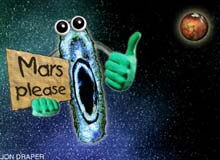Articles and reports from the Life Sciences and chemistry area deal with applied and basic research into modern biology, chemistry and human medicine.
Valuable information can be found on a range of life sciences fields including bacteriology, biochemistry, bionics, bioinformatics, biophysics, biotechnology, genetics, geobotany, human biology, marine biology, microbiology, molecular biology, cellular biology, zoology, bioinorganic chemistry, microchemistry and environmental chemistry.

Is there life on Mars? It’s possible, but it may not be Martian, say scientists. New research, published in the open access journal BMC Microbiology, suggests that conditions on Mars are capable of supporting dormant bacteria, known as endospores. This raises concern about future attempts to detect Martian life forms because endospores originating on Earth could potentially hitch a ride to Mars and survive on its surface.
Soil on Mars is thought to be rich in oxidising chemicals that are known

Scientists have been studying mutant plants that take an unusually long time to flower. At the SEB conference on Thursday 3 April, researchers from Horticulture Research International will present the results of their investigation into a RING finger protein (RING stands for Really Interesting New Gene) involved in regulating when a plant will flower.
Dr Stephen Jackson and colleagues have been working with mutants that have altered flowering times. One particular mutant that takes a long ti

Many shark species, including the great white and mako, swim at speeds greater than their morphology should allow. Dr. Adam Summers (University of California) has discovered they achieve this speed by changing the stiffness of their body by pressurising their thick, inflexible skin. “This study could help answer questions about the evolution of the shark, especially why sharks abandoned a bony skeleton in favour of a cartilage structure,” said Dr. Summers who will be presenting his findings on Frida

The broad barred goby is a coward. A sweeping statement you may say, but even though the goby is poisonous to its predators, the cowardly fish still spends almost all its time cowering in an inaccessible coral home 20-30 cm in diameter. A new study, to be presented to the Society for Experimental biology on Wednesday 3rd April, reveals how the fish has adapted to extremely low oxygen concentrations (hypoxia) in order to avoid venturing out from its coral den.
Dr. Göran Nilsson, from the Univ

Scientists Identify a Protein Channel that Mediates the Body’s Ability to Feel Frigid
A group of researchers from The Scripps Research Institute (TSRI) and the Genomics Institute of the Novartis Research Foundation (GNF) have identified and isolated a novel protein that mediates the body’s ability to sense cold through the skin.
In an article that will appear in this week’s issue of the journal Cell, the group describes the “ion channel” protein, called ANKTM1, which is the

Study shows surprisingly sophisticated nesting behavior in common marsh birds
Coots, the Rodney Dangerfields of the bird world, just might start to get some respect as a result of a new study showing that these common marsh birds are able to recognize and count their own eggs, even in the presence of eggs laid by other birds.
The counting ability of female coots is part of a sophisticated set of defense mechanisms used to thwart other coots who lay eggs in their neighbors